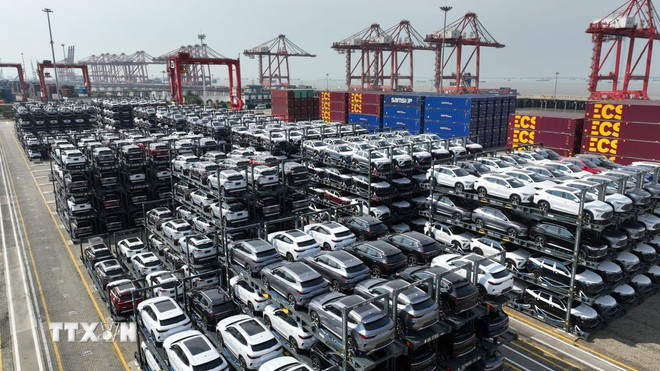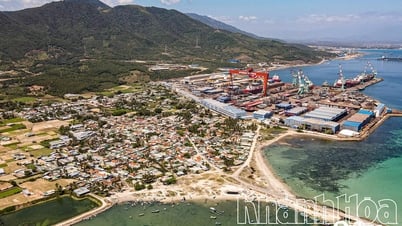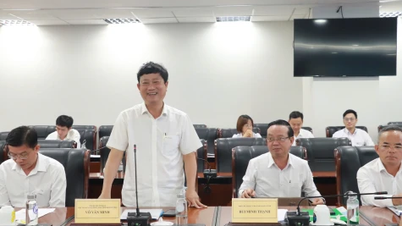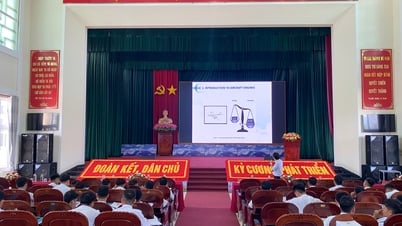On April 2, 2025, US President Donald Trump announced a basic tax rate of 10% on imported goods from all countries and territories around the world . (Photo: THX/TTXVN)
From China's tough retaliation warnings, the EU's cautious response, to the plunge in global stock markets, the world economic outlook has become ever bleaker.
However, Mr. Trump's sudden last-minute "u-turn" somewhat eased tensions, but still left many questions open about the future of international trade.
Trade barriers highest in more than 10 years
On the afternoon of April 2 (local time), US President Donald Trump announced a basic tax rate of 10% on imports from all trading partners and higher tariffs (reciprocal taxes), ranging from 10-49%, on dozens of partners with trade surpluses with the US.
These US tariffs would amount to the highest trade barriers in more than a decade. In addition to the reciprocal tariffs, the US will also impose a 25% tariff on imported cars from April 3.
Among the major economies most affected are the European Union (EU) with a reciprocal tariff of 20% and China with an additional reciprocal tariff of 34%, on top of the current 20%.
 Electric vehicles for export at Taicang port, Jiangsu province, China. (Photo: THX/TTXVN)
Electric vehicles for export at Taicang port, Jiangsu province, China. (Photo: THX/TTXVN)
Shortly after President Trump announced the new tariff plan, US Treasury Secretary Scott Bessent warned other countries against retaliatory measures against US import tariffs, stressing that this could only escalate trade tensions.
Diversity in global response
In response, the Customs Tariff Commission of the State Council of China announced that it will impose an additional 34% tariff on all imported goods originating from the US, in addition to existing tariffs.
The decision took effect on April 10. At the same time, the Chinese Ministry of Commerce added 11 US entities (including Skydio) to its “unreliable entity list” and 16 US entities (including High Point Aerotech) to its export control list.
China also launched an anti-dumping investigation into medical CT tubes imported from the US and India. Notably, China decided to implement export control measures on seven medium and heavy rare earths (samarium, gadolinium, terbium, dysprosium, lutetium, scandium, yttrium), effective immediately.
On April 7 (local time), the US President announced that his administration would impose an additional 50% tax on imported goods from China if the country did not withdraw the 34% retaliatory tax. On the social network Social Truth, President Trump said that the deadline for China to withdraw the tariffs was April 8.
If China fails to comply, an additional 50% tariff will take effect on April 9, bringing the US tariff rate on Chinese goods to 104%. In addition, the US will suspend all negotiations with China held at its request.
Meanwhile, in a softer response, the European Union (EU) has issued a strong warning about responding to new tariffs proposed by President Trump, affirming that it will use "legal, legitimate, proportionate and decisive measures."
The UK government on April 3 launched a four-week consultation with businesses on retaliatory measures against US tariffs if the two countries fail to agree a deal to reduce US tariffs.
Canadian Prime Minister Mark Carney said Canada will impose a 25% tariff on all vehicles imported from the US that do not comply with the US-Mexico-Canada Trade Agreement (USMCA).
The prime ministers of Britain, Australia and Italy have held talks on how to respond to Mr Trump's tariff decision.
The announcement of US tariffs in particular sent shockwaves through financial markets. Last week, all three major Wall Street indexes recorded their biggest two-day declines since the COVID-19 pandemic sparked global panic during President Trump’s first term. The Dow Jones Industrial Average fell 9.3% on April 3-4, the S&P 500 fell 10.5%, and the Nasdaq fell 11.4%.
According to Dow Jones Market Data, the value of US stocks has evaporated about $9.6 trillion since January 17, the last day before President Trump was sworn in for a second term. And about $5 trillion of that “evaporated” in just two sessions on April 3-4, marking the largest two-day decline in market value in history. Meanwhile, Asian and European stock markets also fell sharply.
The White House announced on April 8 that nearly 70 trading partners have proactively contacted the Trump administration to initiate negotiations to minimize the impact of his new tariff policy.
President Trump said the US government is working on “private deals” and will prioritize negotiations with allies such as Japan and South Korea. Top trade official Jamieson Greer also revealed that Argentina, Vietnam and Israel are among the countries that have offered to reduce their tariffs.
While many trading partners seek to negotiate to avoid spiraling into tariffs, the trade war between the US and China continues to escalate.
White House press secretary Karoline Leavitt confirmed on April 8 that a total tariff of 104% will officially be applied to Chinese goods starting April 9. She said that China's retaliatory tariff of 34% on US goods was "wrong" and affirmed that Washington would take appropriate measures.
However, China shows no signs of backing down. On April 9, China announced that from April 10, it will impose an additional 50% tax on goods imported from the US, raising the tax rate from the previous 34% to 84%.
On the same day, a spokesperson for the Chinese Ministry of Commerce also announced that China had filed a lawsuit against the United States over the latest tariff increase under the dispute settlement mechanism of the World Trade Organization (WTO).
On the same day, April 9, EU member states agreed on a plan to implement the first retaliatory measures against US President Donald Trump's tariff policy. Accordingly, the EU will impose tariffs, mainly 25%, on a series of imported goods from the US starting April 15 (local time) as a specific response to US metal tariffs.
The bloc is still assessing how to respond to the auto tariffs and broader duties. The tariffs will come into effect in stages – on April 15, May 16 and December 1. However, the European Commission said that “these retaliatory measures can be suspended at any time if the US agrees to a fair and balanced outcome in the negotiations.”
Unexpected "turn"
In a surprise move by the US administration, Mr. Trump said on April 9 that he would suspend plans to impose reciprocal tariffs for 90 days on all trading partners that do not retaliate against the US.
In a post on the Truth Social social network on the same afternoon local time, President Trump wrote: "Based on the fact that more than 75 trading partners have contacted US representatives, including the Departments of Commerce, Treasury, and the US Trade Representative (USTR), to negotiate solutions to issues related to trade, trade barriers, tariffs, currency manipulation, non-currency tariffs, and these trading partners have not retaliated in any way against the United States, I have authorized a 90-day pause and significantly reduced reciprocal tariffs to 10% during this period, effective immediately."
However, Mr Trump said tariffs on China would now rise to a total of 125% effective immediately, after China responded with a new round of US tariffs.
Treasury Secretary Scott Bessent told reporters after Trump suspended the reciprocal tariffs that the tariffs announced a week ago were meant to bring the countries to the negotiating table.
The Trump administration's decision to suspend tariffs for 90 days on more than 75 trading partners has reversed a negative trend in financial markets after a week of turmoil due to a wave of global tariffs.
Moments after Trump’s tweet, the Dow Jones Industrial Average jumped about 2,500 points. The Nasdaq Composite technology index jumped 12.2%, its biggest one-day gain in 24 years.
Trump’s reversal lifted the entire Dow, with Nvidia leading the way (18.7%). Apple and Boeing both rose more than 15%, while Disney, Goldman Sachs and Nike were among the names that rose more than 10%.
After US President Donald Trump announced his decision to postpone reciprocal tariffs on all trading partners, except China, for 90 days to create an opportunity for negotiations, Canadian Prime Minister Mark Carney and South Korea's trade envoy welcomed the US leader's decision.
In an article on X network, Canadian Prime Minister Carney wrote: "President Trump's announcement to delay the imposition of reciprocal tariffs is a welcome move for the global economy."
In an interview with RTL television, Germany's future Chancellor Friedrich Merz said that President Trump's decision to postpone tariffs on most countries was a demonstration of European solidarity. In another statement to ARD television, Mr. Merz shared his plan to meet the US leader soon after he takes office.
South Korean trade envoy Cheong In Kyo also said that President Trump's temporary suspension of reciprocal tariffs on more than 75 trading partners will create room for negotiations as Seoul seeks to resolve the tariff issue with Washington through dialogue.
WTO Director-General Ngozi Okonjo-Iweala said that the US and China account for 3% of world trade. Therefore, trade tensions between the two countries would "seriously damage the global economic outlook." Meanwhile, according to the WTO's preliminary forecast, goods trade between the US and China could fall by up to 80%.
President Trump's decision to temporarily suspend tariffs, although welcomed by many countries, has not yet been able to completely end the uncertainties in global trade relations.
This “u-turn”, along with the continued escalation of trade tensions with China, shows the unpredictability of US policy and poses great challenges for the international community in finding a sustainable solution to trade disputes.
Will the next 90 days be enough to ease tensions and usher in a new era of global trade, or will it be just the calm before the next storm? The answer remains to be seen./.
According to VNA
Source: https://baothanhhoa.vn/nhin-lai-7-ngay-dia-chan-thuong-mai-toan-cau-245156.htm




![[Photo] General Secretary To Lam chairs a working session with the Central Internal Affairs Commission](https://vphoto.vietnam.vn/thumb/1200x675/vietnam/resource/IMAGE/2025/5/22/3b7790f499da45b2803d8ae253207ef1)

![[Photo] Press delegation meeting to visit Truong Sa and DK1 Platform](https://vphoto.vietnam.vn/thumb/1200x675/vietnam/resource/IMAGE/2025/5/22/6b8d232877ec421a9e8187d83b9f8006)
![[Photo] Prime Minister Pham Minh Chinh chairs meeting on draft Resolution of National Assembly on International Financial Center in Vietnam](https://vphoto.vietnam.vn/thumb/1200x675/vietnam/resource/IMAGE/2025/5/22/d398664ff1a140629169ea5a24e1b4d0)
![[Photo] T&T 1 and Ho Chi Minh City 1 People's Police Teams won the men's and women's team championships](https://vphoto.vietnam.vn/thumb/1200x675/vietnam/resource/IMAGE/2025/5/22/39db06ae67cb4001b7a556e8d9a56d07)






















![[Photo] Prime Minister Pham Minh Chinh chairs the Government's special meeting on law-making in May](https://vphoto.vietnam.vn/thumb/1200x675/vietnam/resource/IMAGE/2025/5/22/1c880aae96fd4e0894abc47a46fe19ba)



















































![[Podcast] Week introducing more than 500 OCOP products in Hanoi](https://vphoto.vietnam.vn/thumb/402x226/vietnam/resource/IMAGE/2025/5/22/d144aac2416744718388dbae3260e7fd)





Comment (0)